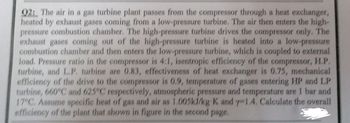
Elements Of Electromagnetics
7th Edition
ISBN: 9780190698614
Author: Sadiku, Matthew N. O.
Publisher: Oxford University Press
expand_more
expand_more
format_list_bulleted
Question
I need the answer as soon as possible

Transcribed Image Text:92: The air in a gas turbine plant passes from the compressor through a heat exchanger,
heated by exhaust gases coming from a low-pressure turbine. The air then enters the high-
pressure combustion chamber. The high-pressure turbine drives the compressor only. The
exhaust gases coming out of the high-pressure turbine is heated into a low-pressure
combustion chamber and then enters the low-pressure turbine, which is coupled to external
load. Pressure ratio in the compressor is 4:1, isentropic efficiency of the compressor, H.P.
turbine, and L.P. turbine are 0.83, effectiveness of heat exchanger is 0.75, mechanical
efficiency of the drive to the compressor is 0.9, temperature of gases entering HP and LP
turbine, 660°C and 625°C respectively, atmospheric pressure and temperature are 1 bar and
17°C. Assume specific heat of gas and air as 1.005kJ/kg K and y-1.4. Calculate the overall
efficiency of the plant that shown in figure in the second page.
Expert Solution
This question has been solved!
Explore an expertly crafted, step-by-step solution for a thorough understanding of key concepts.
Step by stepSolved in 4 steps with 5 images

Knowledge Booster
Learn more about
Need a deep-dive on the concept behind this application? Look no further. Learn more about this topic, mechanical-engineering and related others by exploring similar questions and additional content below.Similar questions
- hints: The flask will be filled with water (at a constant rate of 500 gallons per minute). It will take me exactly 10 minutes to escape from the chains. The diameter of the tank at 1 foot intervals. I am 5 feet 9 inches tall, and I'm pretty skinny so that you can ignore both my volume and the volume of the stool in your analysis. A gallon is equal to 0.13368 cubic feet. You can think of the volume and the height of the water as functions of time. You can easily find an expression for V (t), and then use your expression for volume in terms of height to solve for h(t). after 10 minutes amount of water in the tank=66.84 ft3 t=69.3 minutes h(t)=e66.84t/100pi -1 h(10)=e66.84(10)/100pi -1=7.39 ft Height of stool=1.64 ft Height of water in the tank=7.39 ft Questions: show work How fast is the water rising? I would like to know how long I will have to hold my breath during the last part of the stunt.arrow_forwardi cant see the full workings out even on a pc, please present again so that i can see the whole answer. please make it easy to followarrow_forward6. Please help me solve this mech. engineering questionarrow_forward
- How would I solve this? I am confusion.arrow_forwardMENG364 MANUFACTURING TECHNOLOGY please solve the question very quickly Student Number 124544arrow_forwardhints: The flask will be filled with water (at a constant rate of 500 gallons per minute). It will take me exactly 10 minutes to escape from the chains. The diameter of the tank at 1 foot intervals. I am 5 feet 9 inches tall, and I'm pretty skinny so that you can ignore both my volume and the volume of the stool in your analysis. A gallon is equal to 0.13368 cubic feet. You can think of the volume and the height of the water as functions of time. You can easily find an expression for V (t), and then use your expression for volume in terms of height to solve for h(t). after 10 minutes amount of water in the tank=66.84 ft3 t=69.3 minutes h(t)=e66.84t/100? -1 h(10)=e66.84(10)/100? -1=7.39 ft Height of stool=1.64 ft Height of water in the tank=7.39 ft Questions: show work How fast is the water rising? I would like to know how long I will have to hold my breath during the last part of the stunt.arrow_forward
arrow_back_ios
arrow_forward_ios
Recommended textbooks for you
 Elements Of ElectromagneticsMechanical EngineeringISBN:9780190698614Author:Sadiku, Matthew N. O.Publisher:Oxford University Press
Elements Of ElectromagneticsMechanical EngineeringISBN:9780190698614Author:Sadiku, Matthew N. O.Publisher:Oxford University Press Mechanics of Materials (10th Edition)Mechanical EngineeringISBN:9780134319650Author:Russell C. HibbelerPublisher:PEARSON
Mechanics of Materials (10th Edition)Mechanical EngineeringISBN:9780134319650Author:Russell C. HibbelerPublisher:PEARSON Thermodynamics: An Engineering ApproachMechanical EngineeringISBN:9781259822674Author:Yunus A. Cengel Dr., Michael A. BolesPublisher:McGraw-Hill Education
Thermodynamics: An Engineering ApproachMechanical EngineeringISBN:9781259822674Author:Yunus A. Cengel Dr., Michael A. BolesPublisher:McGraw-Hill Education Control Systems EngineeringMechanical EngineeringISBN:9781118170519Author:Norman S. NisePublisher:WILEY
Control Systems EngineeringMechanical EngineeringISBN:9781118170519Author:Norman S. NisePublisher:WILEY Mechanics of Materials (MindTap Course List)Mechanical EngineeringISBN:9781337093347Author:Barry J. Goodno, James M. GerePublisher:Cengage Learning
Mechanics of Materials (MindTap Course List)Mechanical EngineeringISBN:9781337093347Author:Barry J. Goodno, James M. GerePublisher:Cengage Learning Engineering Mechanics: StaticsMechanical EngineeringISBN:9781118807330Author:James L. Meriam, L. G. Kraige, J. N. BoltonPublisher:WILEY
Engineering Mechanics: StaticsMechanical EngineeringISBN:9781118807330Author:James L. Meriam, L. G. Kraige, J. N. BoltonPublisher:WILEY

Elements Of Electromagnetics
Mechanical Engineering
ISBN:9780190698614
Author:Sadiku, Matthew N. O.
Publisher:Oxford University Press

Mechanics of Materials (10th Edition)
Mechanical Engineering
ISBN:9780134319650
Author:Russell C. Hibbeler
Publisher:PEARSON

Thermodynamics: An Engineering Approach
Mechanical Engineering
ISBN:9781259822674
Author:Yunus A. Cengel Dr., Michael A. Boles
Publisher:McGraw-Hill Education

Control Systems Engineering
Mechanical Engineering
ISBN:9781118170519
Author:Norman S. Nise
Publisher:WILEY

Mechanics of Materials (MindTap Course List)
Mechanical Engineering
ISBN:9781337093347
Author:Barry J. Goodno, James M. Gere
Publisher:Cengage Learning

Engineering Mechanics: Statics
Mechanical Engineering
ISBN:9781118807330
Author:James L. Meriam, L. G. Kraige, J. N. Bolton
Publisher:WILEY